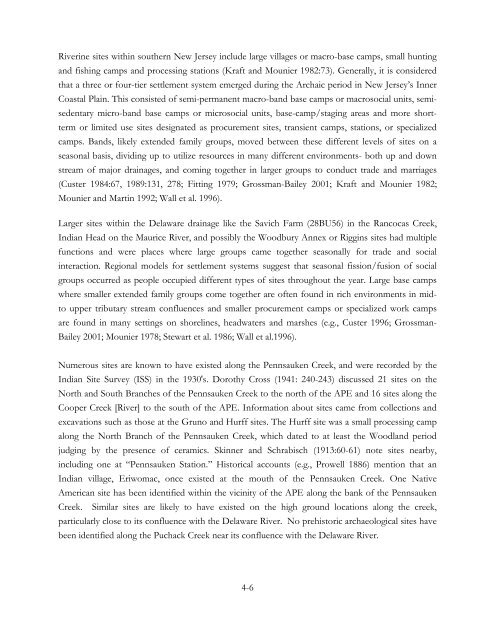APPENDIX D Cultural Resources Survey Report - US Environmental ...
APPENDIX D Cultural Resources Survey Report - US Environmental ...
APPENDIX D Cultural Resources Survey Report - US Environmental ...
Create successful ePaper yourself
Turn your PDF publications into a flip-book with our unique Google optimized e-Paper software.
Riverine sites within southern New Jersey include large villages or macro-base camps, small hunting<br />
and fishing camps and processing stations (Kraft and Mounier 1982:73). Generally, it is considered<br />
that a three or four-tier settlement system emerged during the Archaic period in New Jersey’s Inner<br />
Coastal Plain. This consisted of semi-permanent macro-band base camps or macrosocial units, semi-<br />
sedentary micro-band base camps or microsocial units, base-camp/staging areas and more short-<br />
term or limited use sites designated as procurement sites, transient camps, stations, or specialized<br />
camps. Bands, likely extended family groups, moved between these different levels of sites on a<br />
seasonal basis, dividing up to utilize resources in many different environments- both up and down<br />
stream of major drainages, and coming together in larger groups to conduct trade and marriages<br />
(Custer 1984:67, 1989:131, 278; Fitting 1979; Grossman-Bailey 2001; Kraft and Mounier 1982;<br />
Mounier and Martin 1992; Wall et al. 1996).<br />
Larger sites within the Delaware drainage like the Savich Farm (28BU56) in the Rancocas Creek,<br />
Indian Head on the Maurice River, and possibly the Woodbury Annex or Riggins sites had multiple<br />
functions and were places where large groups came together seasonally for trade and social<br />
interaction. Regional models for settlement systems suggest that seasonal fission/fusion of social<br />
groups occurred as people occupied different types of sites throughout the year. Large base camps<br />
where smaller extended family groups come together are often found in rich environments in midto<br />
upper tributary stream confluences and smaller procurement camps or specialized work camps<br />
are found in many settings on shorelines, headwaters and marshes (e.g., Custer 1996; Grossman-<br />
Bailey 2001; Mounier 1978; Stewart et al. 1986; Wall et al.1996).<br />
Numerous sites are known to have existed along the Pennsauken Creek, and were recorded by the<br />
Indian Site <strong>Survey</strong> (ISS) in the 1930's. Dorothy Cross (1941: 240-243) discussed 21 sites on the<br />
North and South Branches of the Pennsauken Creek to the north of the APE and 16 sites along the<br />
Cooper Creek [River] to the south of the APE. Information about sites came from collections and<br />
excavations such as those at the Gruno and Hurff sites. The Hurff site was a small processing camp<br />
along the North Branch of the Pennsauken Creek, which dated to at least the Woodland period<br />
judging by the presence of ceramics. Skinner and Schrabisch (1913:60-61) note sites nearby,<br />
including one at “Pennsauken Station.” Historical accounts (e.g., Prowell 1886) mention that an<br />
Indian village, Eriwomac, once existed at the mouth of the Pennsauken Creek. One Native<br />
American site has been identified within the vicinity of the APE along the bank of the Pennsauken<br />
Creek. Similar sites are likely to have existed on the high ground locations along the creek,<br />
particularly close to its confluence with the Delaware River. No prehistoric archaeological sites have<br />
been identified along the Puchack Creek near its confluence with the Delaware River.<br />
4-6

















